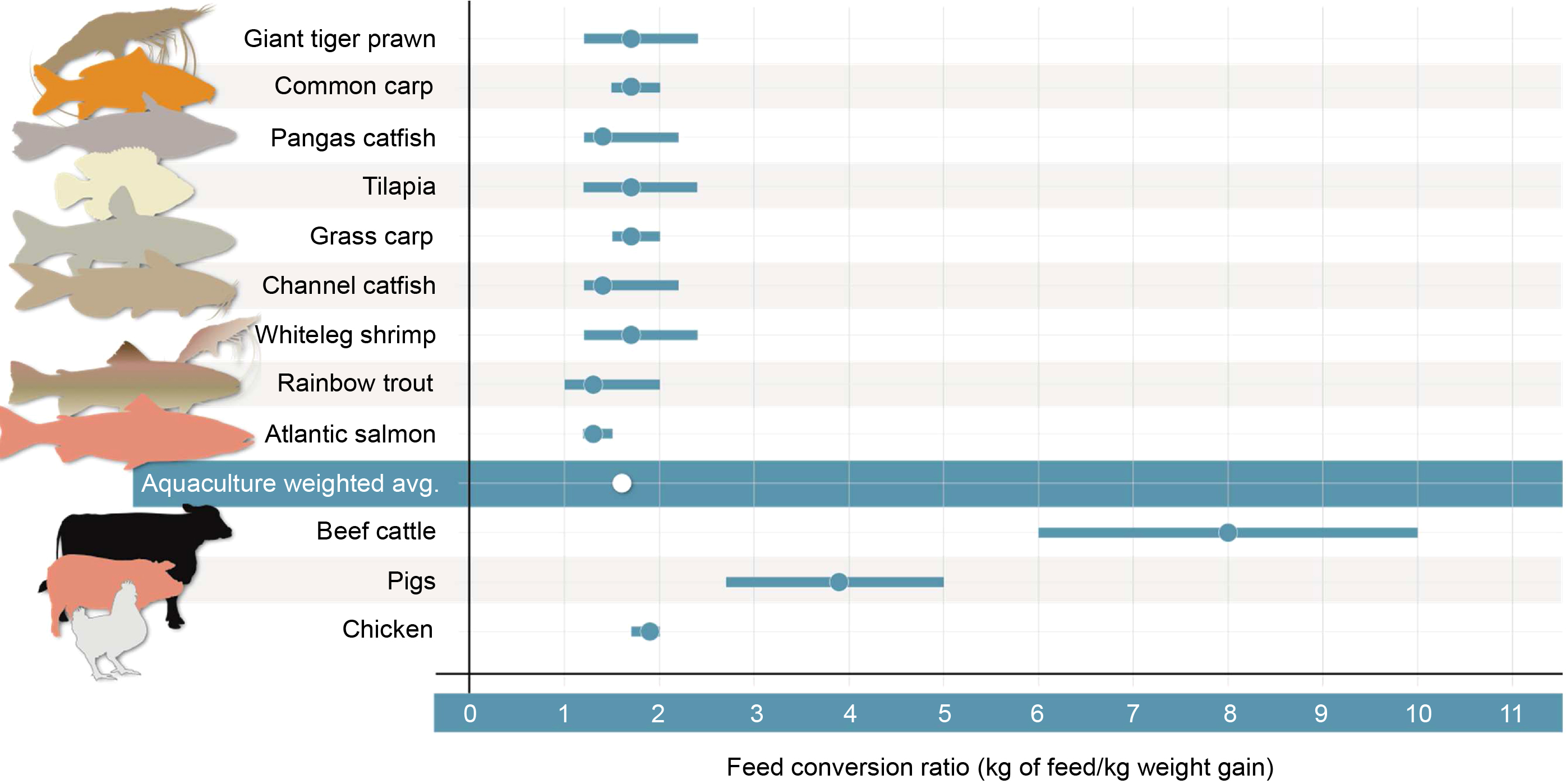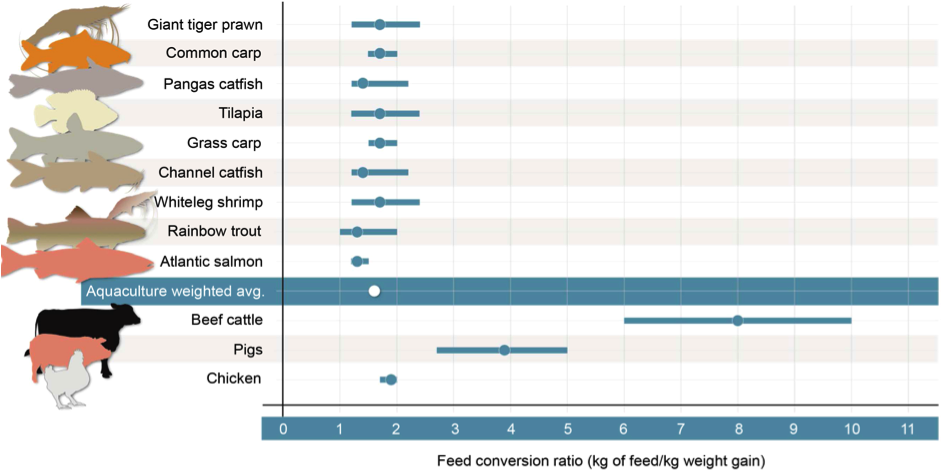
Nordic Aquafarms’ Claims of ‘Sustainably Produced’ Farmed Salmon for a Hungry World Don’t Hold Up
October 9, 2018 | Claudette Bethune
Organic Consumers Association
• Salmon farming is an inefficient, unsustainable and potentially unhealthy method of providing fish for human consumption
• Wild fish are harvested in ever greater amounts to produce feed for farmed salmon instead of simply, and more efficiently, putting wild fish directly into the market for consumers
• Farmed salmon accumulate more toxins such as PCBs and other pesticides from feed than do farmed land animals
• Salmon farmers use vegetable-based feed that also contains terrestrial animal byproducts and synthetic antioxidants that may result in an increase in consumer exposure to pesticides, antibiotic residues, and other harmful contaminants in the farmed salmon
The developers of today’s salmon aquaculture often claim that their industry is “sustainable.” In response to concerns regarding the dangers of open-net salmon pens—where feces, chemicals, parasites and disease are directly transmitted into the bodies of water in which they are located—certain companies are moving their salmon farms on land to “closed-containment” models.
But are these farmed Atlantic salmon any more nutritious or sustainable than farmed land-animals? Is salmon farming really helping to feed a hungry world?
Nordic Aquafarms (NAF), a Norway-based company that proposes to build a mega-sized closed-containment salmon farm in Maine, claims that “the world has a growing need for protein sources produced in a sustainable way” and that “farmed Atlantic salmon has proven to be a more sustainable product than most other comparable protein sources.”
However, reviewing the actual analysis and results in the scientific literature to date, it is clear that the results related to fish feed do not support the typical claims that closed-containment salmon farming operations can produce sustainable or more nutritious products than conventional salmon aquaculture.
Currently, NAF has not yet stated unequivocally or publicly what the company intends to feed the salmon at its proposed Belfast, Maine facility, which is described as “one of the largest [salmon farms] in the world.” However, a review of what is currently used or available for use as feed for farm-raised salmon shows that none of the options pass the sustainability test, nor do they result in a more “nutritious” product for consumption.
Misconceptions around the use of fish meal and fish oils in farmed-fish feed
One of the key concerns about farming carnivorous and omnivorous fish such as Atlantic salmon is the use of fish meal and fish oils as ingredients in feed for farmed salmon. That’s because the production of fish meal and fish oils requires raising or catching vast quantities of other fish to produce—fish that could be directly used for human consumption. From a food security, safety, and sustainability perspective, it is highly questionable that farms that consume more fish in feed than they produce could rival the best available protein alternatives.
To address this concern, the industry makes two claims. One, it is reducing the amount of fish oil and fish meal by substituting plant sources. And two, aquatic animals have more efficient feed-conversion rates than livestock, which makes farmed salmon more sustainable.
Let’s look at the first claim. According to the aquaculture industry, the marine protein and oil portion in farmed Atlantic salmon diets has been reduced by about 30 percent since the 1990s by substituting plant sources. However, given the increase during that same time period in the overall volume of farmed salmon being produced, the 30-percent reduction doesn’t translate into an overall reduction in the use of fish meal and fish oils being diverted from human consumption to the farmed salmon industry. [1]
To put this in perspective, we can use something called the Jevons Paradox to show that the salmon farming industry is actually using more fish meal and more fish oils, as the industry becomes more efficient. The Jevons Paradox says that “as production methods grow more efficient, demand for resources actually increases—rather than decreases, as you might expect.” [2]
This is what has happened with current salmon aquaculture feed. As fish farming has become more efficient, demand for wild fish as a component of fish feed has increased significantly. This has, in turn, put increased demand on the oceans.
Now, let’s look at the second claim—that aquatic animals require less feed and are therefore more sustainable to produce. The salmon aquaculture industry points to the fact that aquatic animals typically have lower (more efficient) feed-conversion rates (FCRs) than large terrestrial animals. This is in part because aquatic animals use less energy to move and regulate their body temperature. As a result, aquaculture is often viewed as an opportunity to meet rising demand for animal products using less feed, especially compared with the feed requirements for pigs and cattle. [3,4]
However, we now know that FCR is a limited measure of efficiency because it accounts only for the weight of feed inputs, and not for the nutritional content of the feed, or the portion of the animal that is inedible, or the nutritional quality of the final product. The use of FCRs relies on the assumption that various species are similar across these areas. That makes it a potentially misleading tool for cross-species comparisons (Figure 1).
It’s important to consider the implications of consuming farmed aquatic animals, such as farmed salmon, that have higher requirements for protein in their diet compared with the protein requirements of terrestrial animals (including humans), and relatively low retention of protein and calories. Salmon aquaculture generally requires more highly nutrient-dense feed than livestock production (i.e. higher in protein and calories), and results in a loss of most protein (81 percent) and calories (90 percent) during production. [5]
Current analysis on FCR across species of farmed animals shows that protein and calorie retention in aquaculture vary by species, are all lower than chickens, and are similar to pig and cattle production, despite the lower feed-conversion rates.
Vegetables and animal byproducts in fish feed raise GMO and pesticide concerns
As stated above, to reduce the use of fish meal and fish oil, the salmon aquaculture industry has steadily increased its use of vegetable protein and oil over the last 20 years. This includes an increase in the use of soy, rapeseed, wheat, palm oil, groundnuts, and corn—and their genetically-modified counterparts. The industry has also increased its use of terrestrial animal byproducts. [6]
With the increased use of vegetables in salmon feed, there has been a concurrent increase and concern for the increase in the allowable limit for pesticides used on plants for fish feed. For example, in 2012, a 10-fold increase in the allowable limit of the pesticide endosulfan was approved for salmon feed, because the pesticide was widely present in plants sourced for feed. [7] This occurred despite the fact that in 2011, the Stockholm Convention on Persistent Organic Pollutants during their 5th meeting added endosulfan to its list of dangerous pollutants because it is known to be highly toxic to humans and wildlife.
In addition to increased levels of pesticides, such as endosulfan, in farmed salmon feeds, other pesticides and contaminants found in fish feed, including PCBs, are known to accumulate in farmed salmon at up to 10-times more than in farmed land animals. National monitoring data on commercial fish feed and farmed Atlantic salmon on the Norwegian market found persistent organic pollutants (POPs) such as PCBs up to 10-times higher than those reported for terrestrial meat products on the same feed. [8]
Compared with wild fisheries, farmed salmon feed also uses synthetic antioxidants, such as ethoxyquin, to prevent the feed going rancid. Ethoxyquin and its metabolites that are present in farmed salmon accumulate from feed at relatively high concentrations and are known to be toxic to dogs, and likely to humans as well. [9]
The use of animal byproducts (pig and chicken) in fish feed raises additional concerns about environmental contaminants and synthetic additives. This practice recycles the contaminants and antibiotic residues from farmed animals in the food chain, even when closed-containment systems themselves do not routinely use antibiotics and other contaminants known to be used in industrial poultry and hog production. [10]
Some have suggested that insects could be used in farmed salmon feed, which would benefit the fish and the consumer. However, the use of insects as fish feed is still unproven. As of yet, there is no evidence of the development of an insect-based compound feed that would be sufficient to supply large salmon aquaculture systems, such as the one proposed by NAF.
As we can see, feeds for livestock and farmed salmon rely largely on the same crops. We know that many of these crops, as well as the forage fish used to make fish feed, are also consumed directly by humans, and provide essential nutrition for low-income households. As salmon aquaculture grows, competition for these crops will increase, and demand for wild fish as feed inputs, will also grow. This will potentially lead to higher prices and price volatility, worsening food insecurity among the most vulnerable populations. [11]
Taken together, we can see that the claims that salmon aquaculture, even on land, is sustainable, more nutritious, or has the potential to feed the world are not founded on actual data or objective results.

Figure 1. Typical feed Conversion Rates (FCRs) show apotentially misleading tool for cross-species comparisons. Example FCRs for animals raised using commercial feeds and intensive production methods (i.e. not extensive production like grazing) are shown in this figure are as follows: beef cattle: 6.0–10.0, pigs: 2.7–5.0, chickens: 1.7–2.0, and farmed fish and shrimp: 1.0–2.4. Adapted from: Feed conversion efficiency in aquaculture: do we measure it correctly? (Jillian P Fry et al 2018 Environ. Res. Lett. 13 024017 doi:10.1088/1748-9326/aaa273)
References:
1. Ytrestoyl T, Aas TS & Asgard,T (2015) Utilisation of feed resources in production of Atlantic salmon (Salmo salar) in Norway. Aquaculture 448, 365–374.
2. Gandhi, M. (2016) Oh fish! What’s wrong in aquaculture and why one needs to educate govt on new fish farm policy. First Post (July 11, 2016). Accessed 5 August 2018 from: https://www.firstpost.com/living/oh-fish-whats-wrong-in-aquaculture-and-why-one-needs-to-educate-govt-on-new-fish-farm-policy-2886938.html
3. Béné C et al. (2005) Feeding 9 billion by 2050—putting fish back on the menu Food Secur. 7, 261–74.
4. High Level Panel of Experts (HLPE) on Food Security and Nutrition(2014). Sustainable Fisheries and Aquaculture for Food Security and Nutrition (Rome: FAO). Accessed 5 August 2018 from: http://www.fao.org/3/a-i3844e.pdf
5. Fry, JP et al. (2018). Feed conversion efficiency in aquaculture: do we measure it correctly? Environ. Res. lett.13 (2): 024017. Accessed 5 August 2018 from: https://doi.org/10.1088/1748-9326/aaa273
6. Fry J P et al. (2016) Environmental health impacts of feeding crops to farmed fish Environ. Int. 91 201–14.
7. Tallaksen, E. (2013) Norway to pass EU law on higher toxin level in salmon feed. Undercurrent news June 12, 2013. Accessed 5 August 2018 from: https://www.undercurrentnews.com/2013/06/12/norway-to-pass-eu-law-on-higher-toxin-level-in-salmon-feed/
8. Berntssen M H et al. (2011) Carry-over of dietary organochlorine pesticides, PCDD/Fs, PCBs, and brominated flame retardants to Atlantic salmon (Salmo salar L.) fillets. Chemosphere. 2011 Mar;83(2):95-103.
9. Błaszczyk A et al. (2013) “Ethoxyquin: An Antioxidant Used in Animal Feed,” International Journal of Food Science, vol. 2013, Article ID 585931, 12 pages, 2013. Accessed 5 August 2018 from: https://doi.org/10.1155/2013/585931.
10. Watts J et al. (2017) The Rising Tide of Antimicrobial Resistance in Aquaculture: Sources, Sinks and Solutions. Mar. Drugs 15(6) 158. Accessed 5 August 2018 from http://www.mdpi.com/1660-3397/15/6/158
11. Troell et al. (2014) Does aquaculture add resilience to the global food system? Proc. Natl. Acad. Sci. U S A. 111(37):13257-63.
Dr. Claudette Bethune, Ph.D., pharmaceutics and pharmacokinetics, is an associate director of clinical development at a pharmaceutical company in California. From 2003 – 2006, Bethune was a senior scientist at the Norwegian Institute for Nutrition and Seafood Safety in Bergen, Norway.
